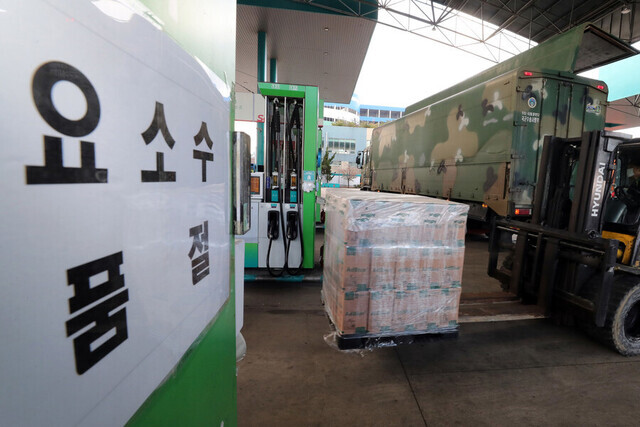hankyoreh
Links to other country sites 다른 나라 사이트 링크
S. Korea more vulnerable to China-based supply chain disruption than US, Japan

South Korea’s supply chain structure is more vulnerable than those of the US or Japan when it comes to intermediate goods manufactured in China, according to a recent study.
The recent shortage of urea water solution, which resulted from developments in China, has focused attention on the reorganization of global supply chains not only for urea, but for the full range of industrial goods.
The Korea Institute for Industrial Economics and Trade (KIET) published a report on Thursday analyzing supply chain vulnerabilities in South Korean industry and their propagation pathways. Its findings listed 1,088 items — including urea, silicon, lithium and magnesium — as “sensitive” due to strategic vulnerabilities observed in South Korean imports from China as of 2020.
Together, they account for over one-fifth of the 5,300 total items that South Korea imports from China. The total includes 604 examples of intermediate goods. Both numbers were up substantially from the 965 total items and 488 intermediate goods counted in 2007.
When an item is seen as “sensitive,” this means that South Korea relies on Chinese imports for over 50% of supplies while maintaining a trade deficit.
Another 653 items — 366 of them intermediate goods — were classified as “vulnerable,” meaning a 70% or greater reliance on imports.
The 1,088 sensitive items accounted for 34.0% of all imports from China, with the 604 sensitive intermediate goods accounting for 25.1%.
In the US, 575 sensitive items represent 56.3% of all imports, while 185 intermediate goods make up 16.8% of imports — a lower rate than in South Korea. In Japan, 1,048 sensitive items account for 62.9% of all imports, with 475 intermediate goods representing 34.5%. This indicates a greater dependence on China in terms of intermediate goods when compared with the US.
In South Korea’s case, vulnerable items accounted for 22.8% of all imports from China, with intermediate goods representing 17.5%. This shows a higher level of reliance on China for imports of intermediate goods than either the US (43.6% vulnerable items, 10.3% intermediate goods) or Japan (37.7% and 13.8%).
To calculate the impact on South Korean industry from potential problems with supplies of vulnerable items from China, KIET used an industry atlas model to analyze industries related to lithium and magnesium.
“Industries with secondary linkages accounting for lithium and magnesium demand were found to include chemicals, rechargeable batteries and semiconductors,” it observed.
“In particular, industries with secondary linkages to magnesium had profound connections not only with similar industries such as steel and non-ferrous metals but also general machinery and transportation machinery,” it noted.
“These close ties between vulnerable supply chain items and South Korea’s mainstay industries raises concerns that secondary damages could occur in the event of a crisis,” it added.
The report’s author, KIET senior researcher Kim Ba-woo, said, “While the South Korean economy’s close cooperative relationship with China makes it more vulnerable than other countries to the kind of systematic supply chain risks we have seen in the current [urea water solution] situation, it would cost an enormous amount to pursue a strategy of domestic production or diversification for all items.”
“We first need to determine which items are most vulnerable, then devise a response strategy based on the nature of those items and the industry connected with them,” he suggested.
By Kim Young-bae, senior staff writer
Please direct questions or comments to [english@hani.co.kr]

Editorial・opinion
![[Column] Season 2 of special prosecutor probe may be coming to Korea soon [Column] Season 2 of special prosecutor probe may be coming to Korea soon](https://flexible.img.hani.co.kr/flexible/normal/500/300/imgdb/original/2024/0426/3317141030699447.jpg) [Column] Season 2 of special prosecutor probe may be coming to Korea soon
[Column] Season 2 of special prosecutor probe may be coming to Korea soon![[Column] Park Geun-hye déjà vu in Yoon Suk-yeol [Column] Park Geun-hye déjà vu in Yoon Suk-yeol](https://flexible.img.hani.co.kr/flexible/normal/500/300/imgdb/original/2024/0424/651713945113788.jpg) [Column] Park Geun-hye déjà vu in Yoon Suk-yeol
[Column] Park Geun-hye déjà vu in Yoon Suk-yeol- [Editorial] New weight of N. Korea’s nuclear threats makes dialogue all the more urgent
- [Guest essay] The real reason Korea’s new right wants to dub Rhee a founding father
- [Column] ‘Choson’: Is it time we start referring to N. Korea in its own terms?
- [Editorial] Japan’s rewriting of history with Korea has gone too far
- [Column] The president’s questionable capacity for dialogue
- [Column] Are chaebol firms just pizza pies for families to divvy up as they please?
- [Column] Has Korea, too, crossed the Rubicon on China?
- [Correspondent’s column] In Japan’s alliance with US, echoes of its past alliances with UK
Most viewed articles
- 1‘We must say no’: Seoul defense chief on Korean, USFK involvement in hypothetical Taiwan crisis
- 2[Column] Season 2 of special prosecutor probe may be coming to Korea soon
- 3N. Korean delegation’s trip to Iran shows how Pyongyang is leveraging ties with Moscow
- 4Amnesty notes ‘erosion’ of freedom of expression in Korea in annual human rights report
- 5Korea sees more deaths than births for 52nd consecutive month in February
- 6[Reportage] On US campuses, student risk arrest as they call for divestment from Israel
- 7[Editorial] New weight of N. Korea’s nuclear threats makes dialogue all the more urgent
- 8‘Weddingflation’ breaks the bank for Korean couples-to-be
- 9Division commander ordered troops to enter raging flood waters before Marine died, survivor says
- 10[Editorial] Korea’s surprise Q1 growth requires objective assessment, not blind fanfare